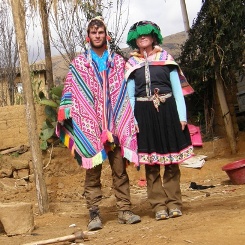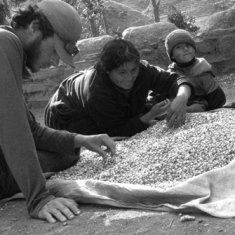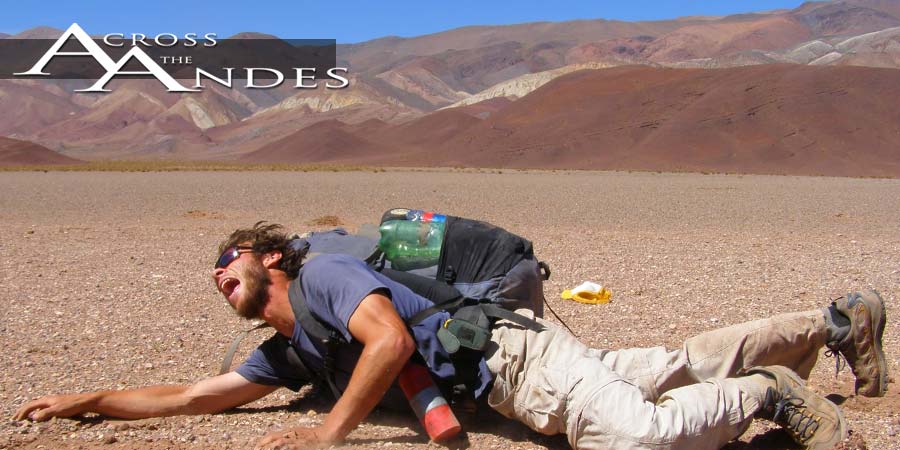Mountains Are Big
By Gregg Treinish
July 20, 2007

It had been snowing on and off for a few days, the cold coming and going in alternating shifts with the sun. We knew that we had to be nearing the Cordillera Vilcanota, having set out three or four days before from the tiny village of Raqchi to begin the section. As we repacked our bags just after lunch and began up the cold valley, a Quechua woman in her twenties and her younger sister offered to lead the way towards the village of Azungante which we had asked directions to in our newly acquired and very basic Quechua tongue. Two hours passed as the cold wind and snows pounded us, dramatically slowing our progress as we traversed the steep hillsides. Glimpses of jagged spires were intermittently visible when the sky would clear. Having become so accustomed to being constantly amazed at this point, we hiked on appreciating the view when it was there, wondering if the snows would let up when it wasn't. We reached the tiny town too early to stop for the day and decided after long deliberations that it would be best if we pushed on to the lake another 1000 meters above. Maybe, if we hurried, we'd even get a view on top of the pass. We climbed, racing the dropping sun to be the first to the horizon. A man on a horse travelling in the opposite direction stopped to chat for a brief while before allowing us to continue the sprint for the top. As darkness approached, the thought of being at 5000 meters in a snowstorm at night was heavily weighing on my mind. I had forgotten to really think about what may lay on the other side of the ridge but hoped it would be forgiving. I caught my breath before pushing the last few feet to the top of the pass, looked back at the valley we had most recently climbed up and out of, and then took those last steps to the ridge. Perhaps because it was so unexpected, perhaps because we were both so drained and exhausted from a series of steep climbs and subsequent drops, whatever the reason, with the sight of Nevado Azungate towering nearly 6,000 feet above the deep blue waters of Lago Pocacocha, with those last few moments of color hanging on to the day, I lost it. It was arguably the single best view that we have yet had on the trip, possibly in my entire life. Tears filled my eyes as I stared in awe at the vastness before me; it was impossible to hold back the emotion of that moment. I looked back briefly, thankful that my hiking partner was close behind and that we'd soon be able to share yet another unforgettable.
We went out in Cusco the other night and happened to see a world map for the first time in a long time. I think that it is often entirely too difficult to appreciate the challenges we face while actually in the midst of overcoming them. Sure, at times it feels like we have been here for a lifetime attempting to accomplish an incomprehensible endless fantasy. Still, the vast majority of the time, especially lately, I wonder how even a week has gone by, let alone the year that has. We are perpetually climbing, struggling, pushing, but all the while I remain content to do what we have chosen to, excited to see what is on top of that next pass, around the next bend, or behind the next range, and to learn from it all. Often, the goal is on my mind: the dream of someday soon walking to that place far down near the end of the world, and not being able to walk anymore... for the ocean to close in around me, and there simply be no place (at least in 3 directions) left to go. Seeing the map the other night, it sank in for a minute or two how far we have really come. As we moved our fingers across Ecuador and Northern Peru, from Santiago to where we stand now, less than 380 crow miles and only a month from having completed the line from Quito to Santiago...unfathomable. I think back to crossing Antisana's pass, our first big one, to the very foreign sounds near Cajas, to that very first family we stayed with now 12 months ago. So much has happened, more importantly though, so much is happening.

In this last month, we have walked through what has easily managed to overshadow those wondrous daydreams of Tierra del Fuego and keep me very much in the moment. Mountains steeper than we have seen, rising out of tropical valleys five, six, seven thousand feet above us, the return of weather in full force, and the challenge that has accompanied all if it has slowed our progress to a mere 8 crow miles per day, this from the 24 or so that we were able to accomplish throughout most of Bolivia. Having left the Cordillera Real in Bolivia, a bit more than disappointed to have to pull out early, we really had no idea that Southern Peru has managed to hide away some of the world's most exhilarating mountains, in some of the most mind-blowing places on earth.
The section began on the Northern shores of Lake Titicaca, and has taken us around 250 crow miles Northwest. Our original plan was to walk a straight line to Queropalca and the end of this section. It was only about two days before we decided to dramatically alter our course and head for the heart of Southern Peru's toughest terrain, this, despite adding more than a few miles to our already pretty damn long trek. As we were finishing our first year, I wrote sometime in my journal that I would make every effort to celebrate life on the second year of this hike, that I would seize every opportunity to climb peaks, see penguins, and enjoy this often overwhelming adventure. The decision to head for the Cordillera Vilcanota largely made itself, and man am I happy that it did. Moving from one range to the next, climbing over a saddle only to see another, even bigger one in the distance and walk to it, this is what it is all about. We have crossed three major ranges since we last wrote, none of which we knew existed upon our return to Peru. What a dream it has been
As we have written many times in the past, the people living in the high reaches of the Andes have been interesting to say the least. Moving across the ranges, we have encountered more than a few characters worth mentioning. There is a new trend that we have encountered, well, it is at least new to us. At least three times now we have been chased down, literally watching as the local men send troops around the flank, and sprint after us up and sometimes even over passes. The "authorities" of the communities that we walk through explain that no one comes through there ever, and that "everyone is always looking for something." We desperately try to explain that we are not there to rob the locals, to search for mineable minerals, or to in any other way destroy what they in the valley have worked for so long to preserve, that in fact we are interested in quite the contrary. We show maps, we read and translate journal entries, even photos don't always do the trick, it usually takes about 45 minutes to convince them to let us pass if we haven't been ordered to spend the night with them. We have stayed, in the last month, with 3 communities' presidents, we have stayed in the local government offices, we have even stayed with the lady in charge of the Alpaca sweater makers that run the tiny town of Vilcamarca which they swear isn't a town, simply a group of people living in a small condensed area. The local authorities have certainly managed to make their presences known, but aren't the only ones around. We met our first South American raised in the campo who wasn't a devout catholic, and actually talked freely about religion with him, we were offered and brought cheese on horseback, we were begged to dance and drink all night by campo women, we were treated to a piano concert, to more potatoes than anyone could ever want, we were even asked to be the god parents of a one-year-old baby boy, and perhaps more frequently than anything else, have been ordered to "Give me sweets!" this making us very happy that we usually do not hike in tourist areas. Whomever started the trend of giving things like candy to the locals has surely managed to make it impossible to have any meaningful exchange with the people living in the often over-visited areas. Thanks buddy!

I am incredibly excited to note that this will be our last update before we return to Queropalca in the Cordillera Huyaush. At the same time, I have been realizing how much I will miss the northern part of South America when this section is over. It is the true cultural center of the Americas, a unique place where people live as they have long ago, and respect what they rely on. The connection to the land, to their history, and to one another is something that we have learned a tremendous amount from in the last year. It will be hard to leave this way of life and make the change to the South. It may be a bit longer than a month until our next updates as we are going to push for the end of this section. May the force be with you.







